Economics Assignment: Unemployment in Australia Analysis
VerifiedAdded on 2021/06/18
|14
|3320
|29
Report
AI Summary
This economics report provides a comprehensive overview of unemployment in Australia over the past five years, examining its trends, causes, and impacts on the Australian economy. The report analyzes the unemployment rate, including youth and long-term unemployment, and discusses factors contributing to job losses and reduced opportunities. It delves into the economic consequences of unemployment, such as decreased living standards and wealth disparity, and explores the Australian government's policies aimed at reducing unemployment. The report highlights the adverse effects of long-term unemployment on individual well-being and social issues, while also acknowledging the impact on economic growth. The report also includes figures illustrating unemployment rates, and underemployment trends. This report provides valuable insights into the challenges and complexities of unemployment within the Australian context.
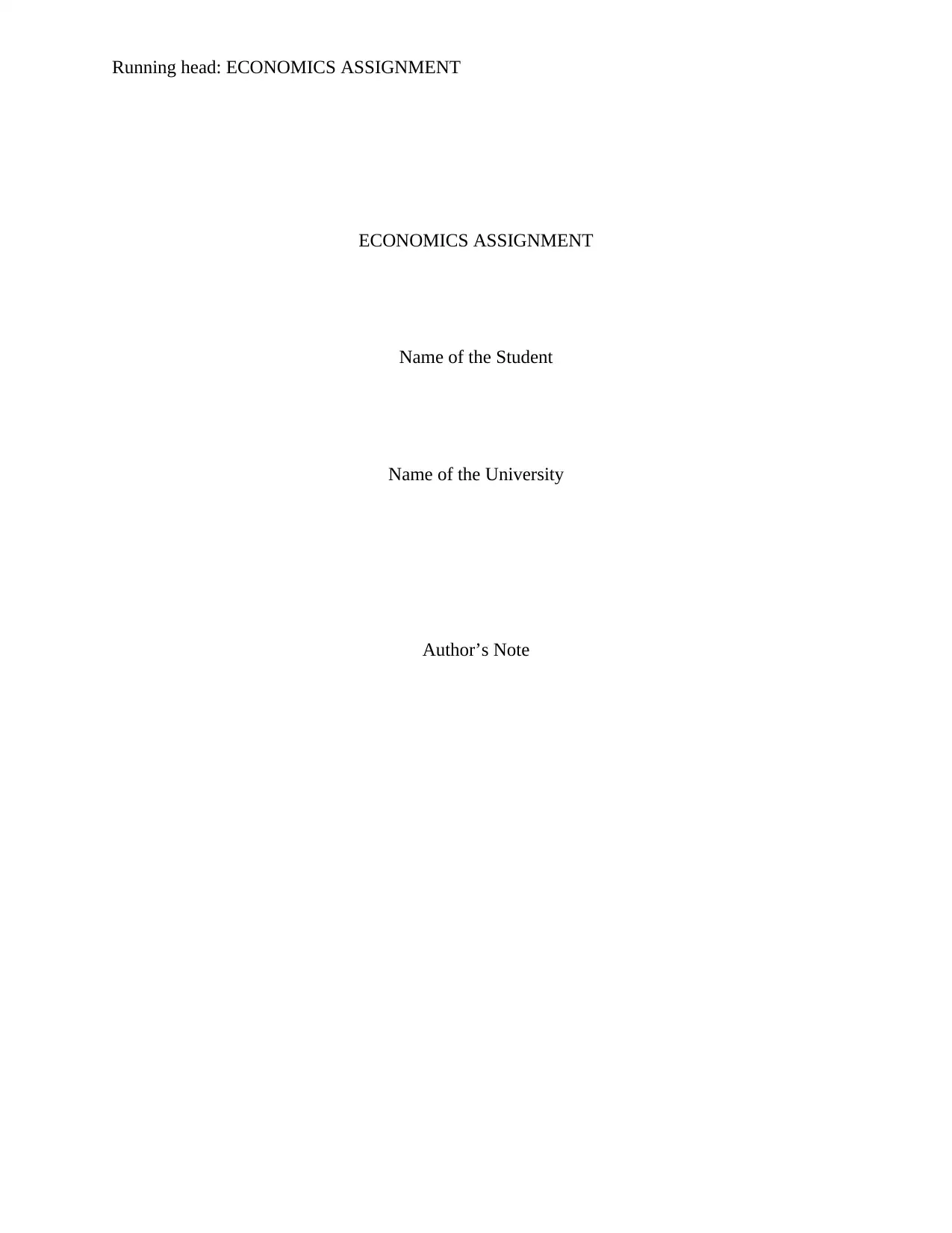
Running head: ECONOMICS ASSIGNMENT
ECONOMICS ASSIGNMENT
Name of the Student
Name of the University
Author’s Note
ECONOMICS ASSIGNMENT
Name of the Student
Name of the University
Author’s Note
Paraphrase This Document
Need a fresh take? Get an instant paraphrase of this document with our AI Paraphraser
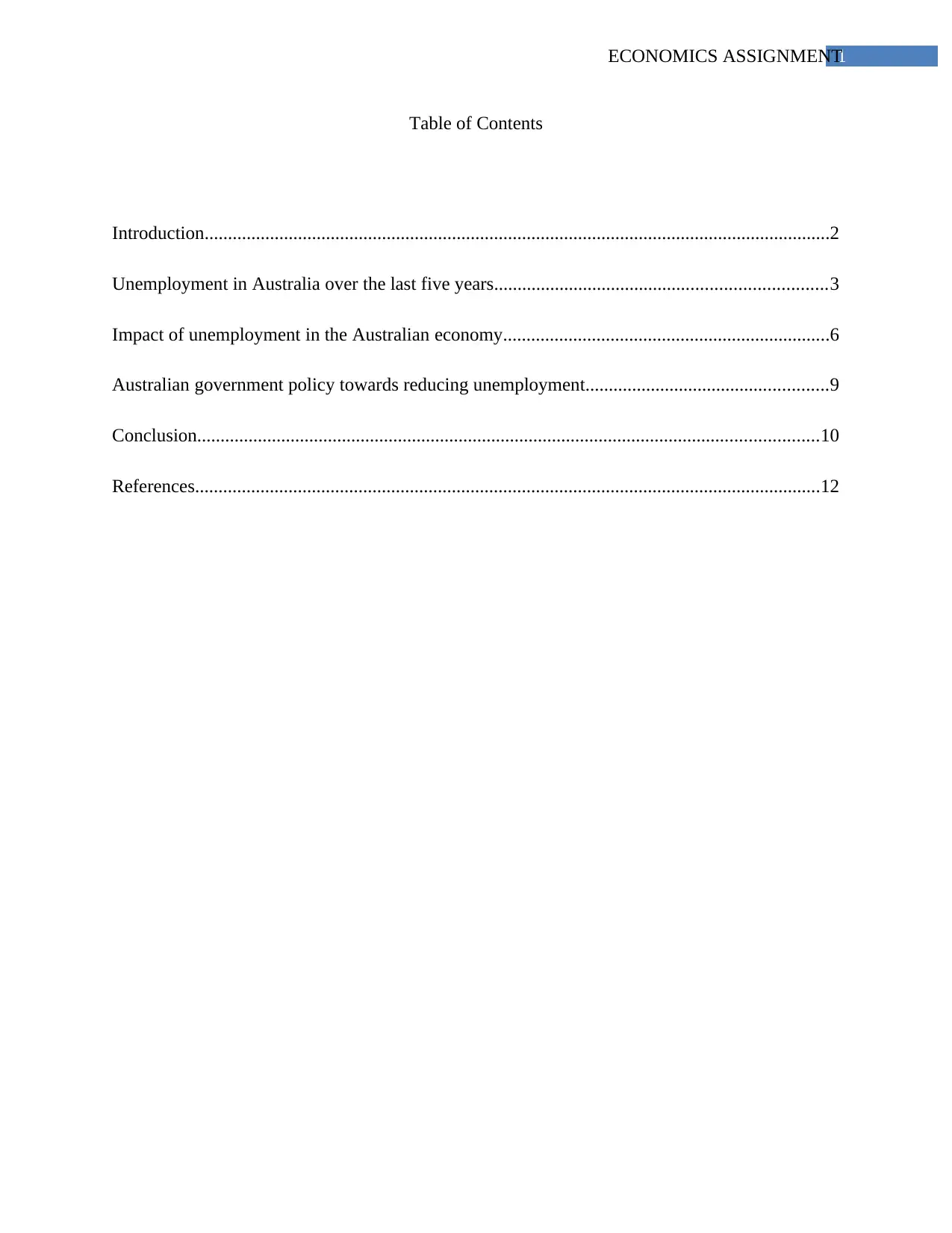
1ECONOMICS ASSIGNMENT
Table of Contents
Introduction......................................................................................................................................2
Unemployment in Australia over the last five years.......................................................................3
Impact of unemployment in the Australian economy......................................................................6
Australian government policy towards reducing unemployment....................................................9
Conclusion.....................................................................................................................................10
References......................................................................................................................................12
Table of Contents
Introduction......................................................................................................................................2
Unemployment in Australia over the last five years.......................................................................3
Impact of unemployment in the Australian economy......................................................................6
Australian government policy towards reducing unemployment....................................................9
Conclusion.....................................................................................................................................10
References......................................................................................................................................12

2ECONOMICS ASSIGNMENT
Introduction
This report provides an overview on the unemployment in Australia during the last five
years and its impact on this economy. Unemployment relates to the situation that occurs when an
individual actively search for employment but is not being presently employed (Gregory and
Smith 2016). Unemployment is a bane in the nation at all levels of the economic development. It
usually brings despair as well as poverty from mainstream way of people’s life. Different nations
follow different theories for estimating unemployment in the nation. Australia thereby follows
standard unemployment definition that is based on ILO (International Labor Organization)
classification. Based on this, an individual in this country is taken into account as unemployed if
the individual has not done paid work for at least an hour in one week and has been actively
seeking work as well as eager to accept any job in coming week. This signifies that the
individuals who are not seeking for job are thereby not involved in computation of
unemployment in this country (Hutchens 2018). Over the last five years, unemployment has been
one of the consistent issues for the economy of Australia. With huge variation in manufacturing
patterns, there has been loss of several jobs in this nation, which in turn lead to reduced job
opportunities. As a result, this enhanced total unemployment in this economy. In fact,
unemployment in this particular country has not been consistent across the groups. The
individuals who have high unemployment risk in this country are immigrants, youth and single
person. Few main concern areas relating to unemployment in this nation are youth
unemployment, long term employment and huge lack of employment opportunities for the older
laborers (Mankiw 2014). Moreover, the Australian government has taken extensive efforts for
tackling this unemployment issue and keeping rate of unemployment at lower levels. The
Introduction
This report provides an overview on the unemployment in Australia during the last five
years and its impact on this economy. Unemployment relates to the situation that occurs when an
individual actively search for employment but is not being presently employed (Gregory and
Smith 2016). Unemployment is a bane in the nation at all levels of the economic development. It
usually brings despair as well as poverty from mainstream way of people’s life. Different nations
follow different theories for estimating unemployment in the nation. Australia thereby follows
standard unemployment definition that is based on ILO (International Labor Organization)
classification. Based on this, an individual in this country is taken into account as unemployed if
the individual has not done paid work for at least an hour in one week and has been actively
seeking work as well as eager to accept any job in coming week. This signifies that the
individuals who are not seeking for job are thereby not involved in computation of
unemployment in this country (Hutchens 2018). Over the last five years, unemployment has been
one of the consistent issues for the economy of Australia. With huge variation in manufacturing
patterns, there has been loss of several jobs in this nation, which in turn lead to reduced job
opportunities. As a result, this enhanced total unemployment in this economy. In fact,
unemployment in this particular country has not been consistent across the groups. The
individuals who have high unemployment risk in this country are immigrants, youth and single
person. Few main concern areas relating to unemployment in this nation are youth
unemployment, long term employment and huge lack of employment opportunities for the older
laborers (Mankiw 2014). Moreover, the Australian government has taken extensive efforts for
tackling this unemployment issue and keeping rate of unemployment at lower levels. The
⊘ This is a preview!⊘
Do you want full access?
Subscribe today to unlock all pages.

Trusted by 1+ million students worldwide
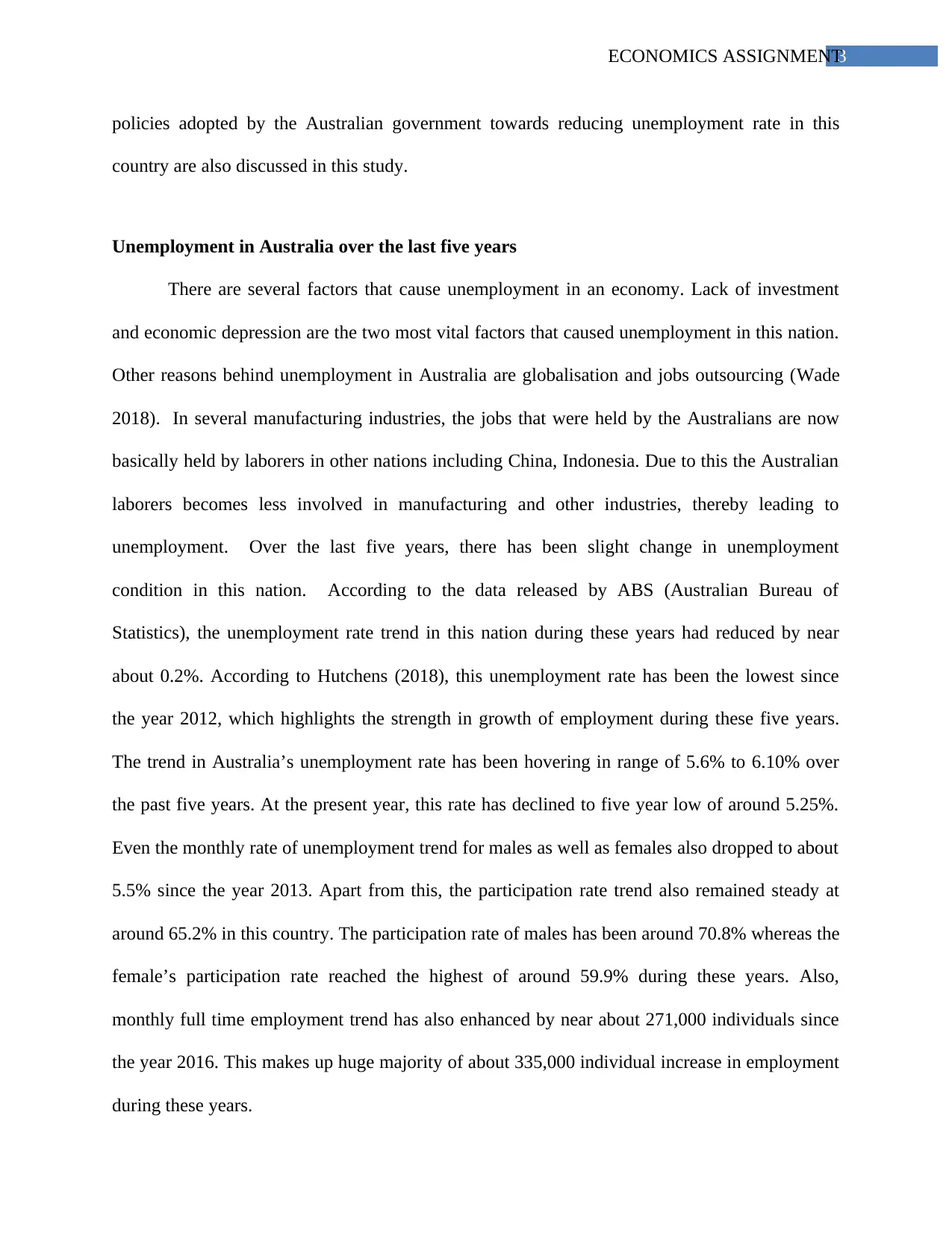
3ECONOMICS ASSIGNMENT
policies adopted by the Australian government towards reducing unemployment rate in this
country are also discussed in this study.
Unemployment in Australia over the last five years
There are several factors that cause unemployment in an economy. Lack of investment
and economic depression are the two most vital factors that caused unemployment in this nation.
Other reasons behind unemployment in Australia are globalisation and jobs outsourcing (Wade
2018). In several manufacturing industries, the jobs that were held by the Australians are now
basically held by laborers in other nations including China, Indonesia. Due to this the Australian
laborers becomes less involved in manufacturing and other industries, thereby leading to
unemployment. Over the last five years, there has been slight change in unemployment
condition in this nation. According to the data released by ABS (Australian Bureau of
Statistics), the unemployment rate trend in this nation during these years had reduced by near
about 0.2%. According to Hutchens (2018), this unemployment rate has been the lowest since
the year 2012, which highlights the strength in growth of employment during these five years.
The trend in Australia’s unemployment rate has been hovering in range of 5.6% to 6.10% over
the past five years. At the present year, this rate has declined to five year low of around 5.25%.
Even the monthly rate of unemployment trend for males as well as females also dropped to about
5.5% since the year 2013. Apart from this, the participation rate trend also remained steady at
around 65.2% in this country. The participation rate of males has been around 70.8% whereas the
female’s participation rate reached the highest of around 59.9% during these years. Also,
monthly full time employment trend has also enhanced by near about 271,000 individuals since
the year 2016. This makes up huge majority of about 335,000 individual increase in employment
during these years.
policies adopted by the Australian government towards reducing unemployment rate in this
country are also discussed in this study.
Unemployment in Australia over the last five years
There are several factors that cause unemployment in an economy. Lack of investment
and economic depression are the two most vital factors that caused unemployment in this nation.
Other reasons behind unemployment in Australia are globalisation and jobs outsourcing (Wade
2018). In several manufacturing industries, the jobs that were held by the Australians are now
basically held by laborers in other nations including China, Indonesia. Due to this the Australian
laborers becomes less involved in manufacturing and other industries, thereby leading to
unemployment. Over the last five years, there has been slight change in unemployment
condition in this nation. According to the data released by ABS (Australian Bureau of
Statistics), the unemployment rate trend in this nation during these years had reduced by near
about 0.2%. According to Hutchens (2018), this unemployment rate has been the lowest since
the year 2012, which highlights the strength in growth of employment during these five years.
The trend in Australia’s unemployment rate has been hovering in range of 5.6% to 6.10% over
the past five years. At the present year, this rate has declined to five year low of around 5.25%.
Even the monthly rate of unemployment trend for males as well as females also dropped to about
5.5% since the year 2013. Apart from this, the participation rate trend also remained steady at
around 65.2% in this country. The participation rate of males has been around 70.8% whereas the
female’s participation rate reached the highest of around 59.9% during these years. Also,
monthly full time employment trend has also enhanced by near about 271,000 individuals since
the year 2016. This makes up huge majority of about 335,000 individual increase in employment
during these years.
Paraphrase This Document
Need a fresh take? Get an instant paraphrase of this document with our AI Paraphraser

4ECONOMICS ASSIGNMENT
According to ABS, this economy has also recorded 20th consecutive quarter of decreasing
growth in wages for the private sector laborers. The conditions of the labor market also
strengthened between the year 2015 and 2016. Although the unemployment rate in the year 2015
was above the target level, the unemployment level fell by around 3.12% between the year 2015
and 2016. This decline in the rate of unemployment occurred along with 0.1% increase in
participation rate during these years. As a result, the employment growth became strong during
the second quarter of 2015 in comparison with previous years. Improvement in this nation’s
labor market during these years reflects that there had been structural shift towards labor-
intensive service industry. In addition to this, strong growth had also been recorded in several
service based sectors during these years. Recent evidences reflect that the employment rate
increased mainly in retail trade, social assistance construction industry, health care and mining
industry. It has also been reflected from few studies that conditions for the young individuals
also improved owing to strengthening in labor market. Furthermore, this nation’s youth
unemployment rate also reduced marginally during these five years even though it remained
more than twice the recorded rate for all individuals (Aph.gov.au. 2018). On the other hand, the
youth employment level enhanced during these period owing to increase in the part-time
employment. In contrast to these, the full time employment of youth decreased by about 1.0%
during this period.
Even though unemployment rate was steady during these years, underemployment
remained higher. Underemployment is one of the vital indicators that highlights on the
underutilized workers in an economy. Underemployment mainly impacts the younger laborers
more than the older laborers in a nation (ABC News. 2018). The ABS basically defines an
individual as underemployed if they works for full time and are forced to work as part time due
According to ABS, this economy has also recorded 20th consecutive quarter of decreasing
growth in wages for the private sector laborers. The conditions of the labor market also
strengthened between the year 2015 and 2016. Although the unemployment rate in the year 2015
was above the target level, the unemployment level fell by around 3.12% between the year 2015
and 2016. This decline in the rate of unemployment occurred along with 0.1% increase in
participation rate during these years. As a result, the employment growth became strong during
the second quarter of 2015 in comparison with previous years. Improvement in this nation’s
labor market during these years reflects that there had been structural shift towards labor-
intensive service industry. In addition to this, strong growth had also been recorded in several
service based sectors during these years. Recent evidences reflect that the employment rate
increased mainly in retail trade, social assistance construction industry, health care and mining
industry. It has also been reflected from few studies that conditions for the young individuals
also improved owing to strengthening in labor market. Furthermore, this nation’s youth
unemployment rate also reduced marginally during these five years even though it remained
more than twice the recorded rate for all individuals (Aph.gov.au. 2018). On the other hand, the
youth employment level enhanced during these period owing to increase in the part-time
employment. In contrast to these, the full time employment of youth decreased by about 1.0%
during this period.
Even though unemployment rate was steady during these years, underemployment
remained higher. Underemployment is one of the vital indicators that highlights on the
underutilized workers in an economy. Underemployment mainly impacts the younger laborers
more than the older laborers in a nation (ABC News. 2018). The ABS basically defines an
individual as underemployed if they works for full time and are forced to work as part time due
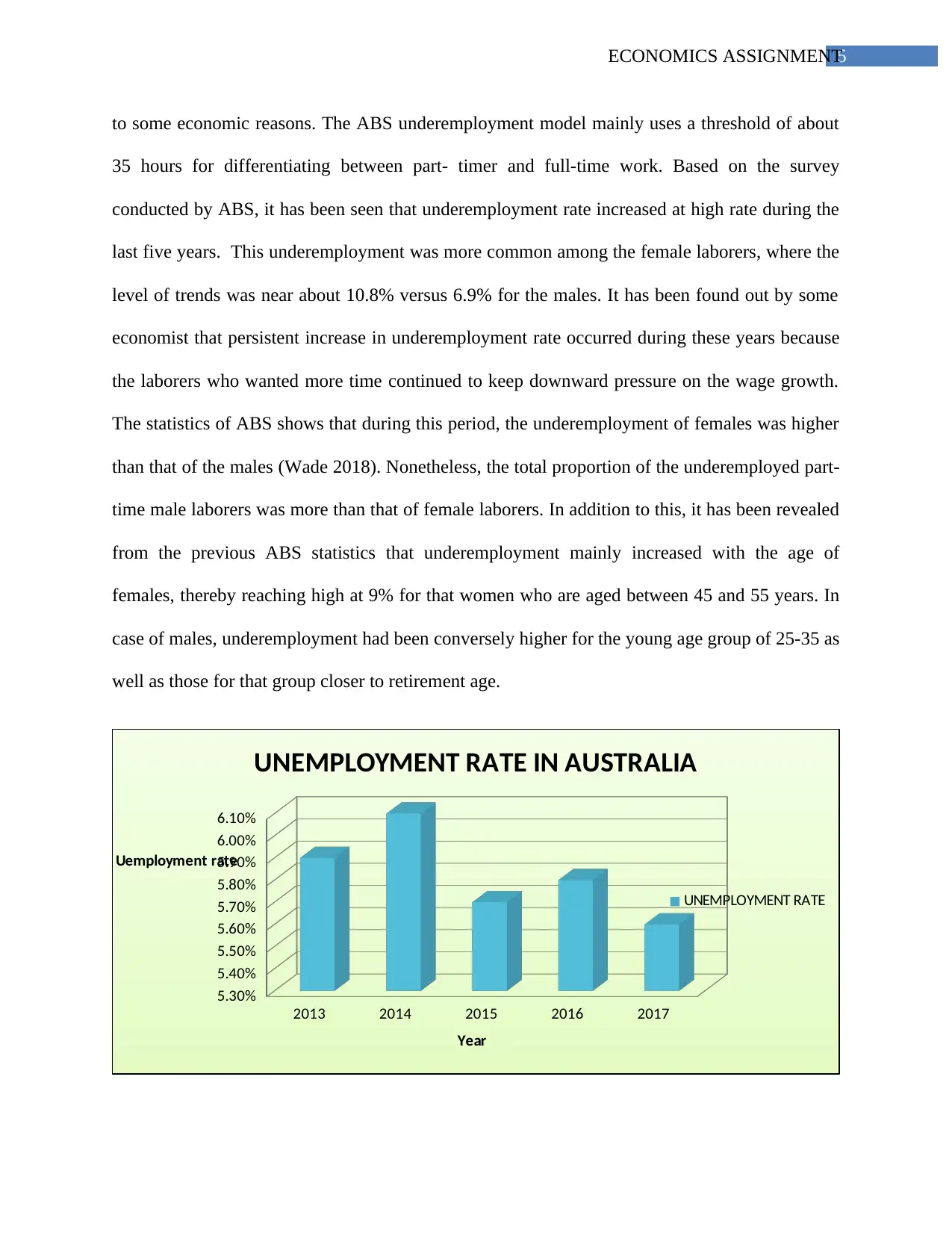
5ECONOMICS ASSIGNMENT
to some economic reasons. The ABS underemployment model mainly uses a threshold of about
35 hours for differentiating between part- timer and full-time work. Based on the survey
conducted by ABS, it has been seen that underemployment rate increased at high rate during the
last five years. This underemployment was more common among the female laborers, where the
level of trends was near about 10.8% versus 6.9% for the males. It has been found out by some
economist that persistent increase in underemployment rate occurred during these years because
the laborers who wanted more time continued to keep downward pressure on the wage growth.
The statistics of ABS shows that during this period, the underemployment of females was higher
than that of the males (Wade 2018). Nonetheless, the total proportion of the underemployed part-
time male laborers was more than that of female laborers. In addition to this, it has been revealed
from the previous ABS statistics that underemployment mainly increased with the age of
females, thereby reaching high at 9% for that women who are aged between 45 and 55 years. In
case of males, underemployment had been conversely higher for the young age group of 25-35 as
well as those for that group closer to retirement age.
2013 2014 2015 2016 2017
5.30%
5.40%
5.50%
5.60%
5.70%
5.80%
5.90%
6.00%
6.10%
UNEMPLOYMENT RATE IN AUSTRALIA
UNEMPLOYMENT RATE
Year
Uemployment rate
to some economic reasons. The ABS underemployment model mainly uses a threshold of about
35 hours for differentiating between part- timer and full-time work. Based on the survey
conducted by ABS, it has been seen that underemployment rate increased at high rate during the
last five years. This underemployment was more common among the female laborers, where the
level of trends was near about 10.8% versus 6.9% for the males. It has been found out by some
economist that persistent increase in underemployment rate occurred during these years because
the laborers who wanted more time continued to keep downward pressure on the wage growth.
The statistics of ABS shows that during this period, the underemployment of females was higher
than that of the males (Wade 2018). Nonetheless, the total proportion of the underemployed part-
time male laborers was more than that of female laborers. In addition to this, it has been revealed
from the previous ABS statistics that underemployment mainly increased with the age of
females, thereby reaching high at 9% for that women who are aged between 45 and 55 years. In
case of males, underemployment had been conversely higher for the young age group of 25-35 as
well as those for that group closer to retirement age.
2013 2014 2015 2016 2017
5.30%
5.40%
5.50%
5.60%
5.70%
5.80%
5.90%
6.00%
6.10%
UNEMPLOYMENT RATE IN AUSTRALIA
UNEMPLOYMENT RATE
Year
Uemployment rate
⊘ This is a preview!⊘
Do you want full access?
Subscribe today to unlock all pages.

Trusted by 1+ million students worldwide
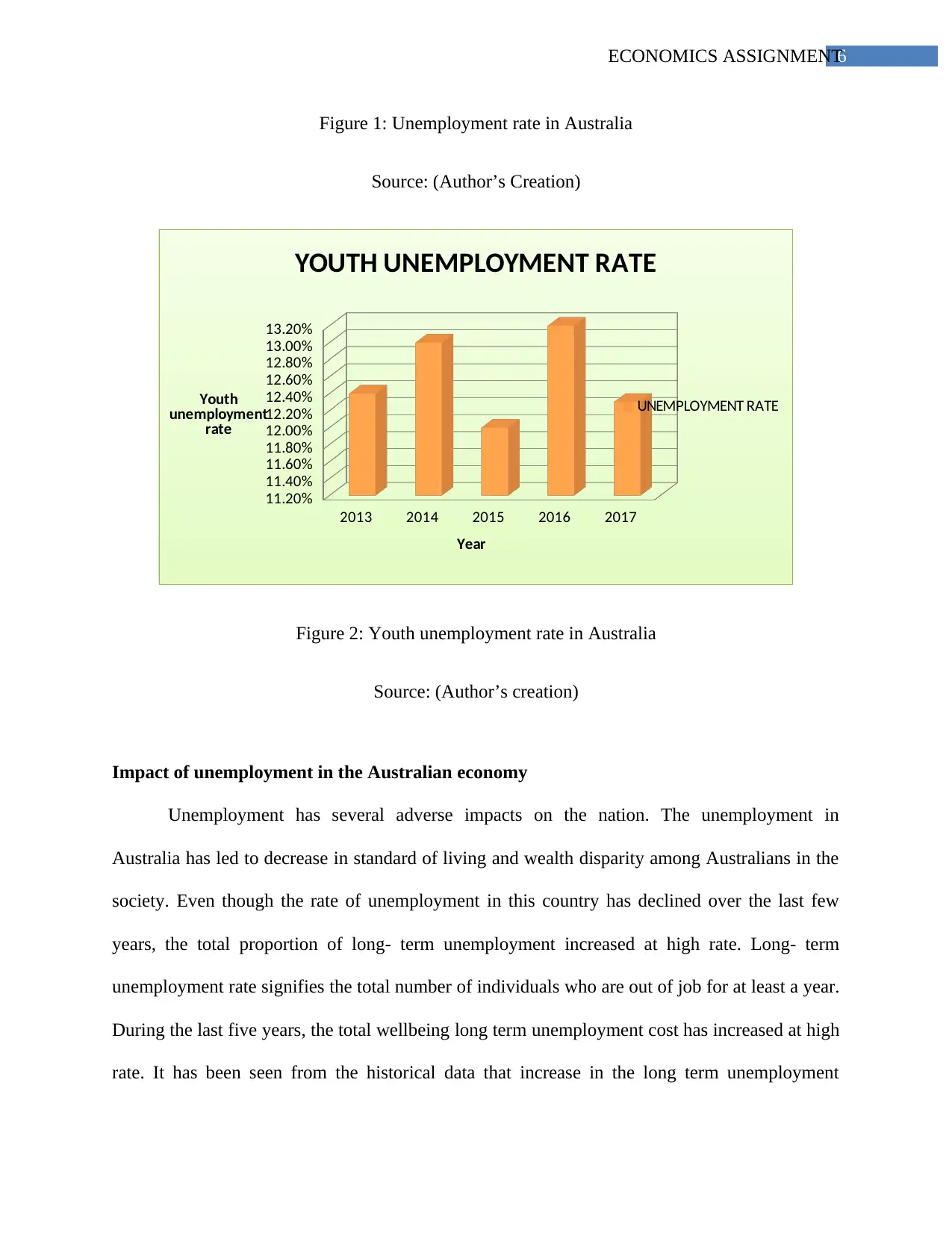
6ECONOMICS ASSIGNMENT
Figure 1: Unemployment rate in Australia
Source: (Author’s Creation)
2013 2014 2015 2016 2017
11.20%
11.40%
11.60%
11.80%
12.00%
12.20%
12.40%
12.60%
12.80%
13.00%
13.20%
YOUTH UNEMPLOYMENT RATE
UNEMPLOYMENT RATE
Year
Youth
unemployment
rate
Figure 2: Youth unemployment rate in Australia
Source: (Author’s creation)
Impact of unemployment in the Australian economy
Unemployment has several adverse impacts on the nation. The unemployment in
Australia has led to decrease in standard of living and wealth disparity among Australians in the
society. Even though the rate of unemployment in this country has declined over the last few
years, the total proportion of long- term unemployment increased at high rate. Long- term
unemployment rate signifies the total number of individuals who are out of job for at least a year.
During the last five years, the total wellbeing long term unemployment cost has increased at high
rate. It has been seen from the historical data that increase in the long term unemployment
Figure 1: Unemployment rate in Australia
Source: (Author’s Creation)
2013 2014 2015 2016 2017
11.20%
11.40%
11.60%
11.80%
12.00%
12.20%
12.40%
12.60%
12.80%
13.00%
13.20%
YOUTH UNEMPLOYMENT RATE
UNEMPLOYMENT RATE
Year
Youth
unemployment
rate
Figure 2: Youth unemployment rate in Australia
Source: (Author’s creation)
Impact of unemployment in the Australian economy
Unemployment has several adverse impacts on the nation. The unemployment in
Australia has led to decrease in standard of living and wealth disparity among Australians in the
society. Even though the rate of unemployment in this country has declined over the last few
years, the total proportion of long- term unemployment increased at high rate. Long- term
unemployment rate signifies the total number of individuals who are out of job for at least a year.
During the last five years, the total wellbeing long term unemployment cost has increased at high
rate. It has been seen from the historical data that increase in the long term unemployment
Paraphrase This Document
Need a fresh take? Get an instant paraphrase of this document with our AI Paraphraser

7ECONOMICS ASSIGNMENT
mainly cost this nation more than decline in its TOT ( Terms of Trade). It has been evident from
recent studies that long term unemployment rate damages the well being of Australia. According
to the data generated by ABS, the total number declined by near about 18% for reaching to
188,000. One of the adverse impacts of long term unemployment is the skills atrophy. This
means that longer the individuals stays out from work, it is probable that their skills might start
to deteriorate through deficiency in training. Although huge increase in national income in this
economy improved the people’s well-being, it has been offset by worsening long term
unemployment rate. The overall outcome of well- being index shows that national well- being
has been lagging in GDP (Gross Domestic Product) of this country (Evans and Honkapohja
2012). In addition to this, long- term unemployment rate has adversely affected both personal as
well as social well being of persons, which includes- debt, housing stress, financial hardships,
enhanced social isolation, alienation and so on.
The Australians have unambiguously demonstrated strong relation between health and
unemployment (Myles et al. 2017). Furthermore, it has been found out by ABS that, the
individuals aged more than 15 years who are long-term unemployed have poor health in
comparison with the employed individuals. It has been pointed out by some researchers that the
long-term unemployed Australians have three times more behavioral as well as mental problems
as compared to the employed individuals. Apart from this, long-term unemployment has also
social impact on the Australians. The long –term unemployed people residing in this nation are
mainly more vulnerable to shame, crime, alienation and enhanced social isolation. It has been
cited by Sloman, Norris and Garrett (2013) that, long-term unemployment is considerably
intergenerational, thereby having an association with the behavioral problem of children as well
as their adjustment over certain period of time. According to Tanveer Choudhry, Marelli. and
mainly cost this nation more than decline in its TOT ( Terms of Trade). It has been evident from
recent studies that long term unemployment rate damages the well being of Australia. According
to the data generated by ABS, the total number declined by near about 18% for reaching to
188,000. One of the adverse impacts of long term unemployment is the skills atrophy. This
means that longer the individuals stays out from work, it is probable that their skills might start
to deteriorate through deficiency in training. Although huge increase in national income in this
economy improved the people’s well-being, it has been offset by worsening long term
unemployment rate. The overall outcome of well- being index shows that national well- being
has been lagging in GDP (Gross Domestic Product) of this country (Evans and Honkapohja
2012). In addition to this, long- term unemployment rate has adversely affected both personal as
well as social well being of persons, which includes- debt, housing stress, financial hardships,
enhanced social isolation, alienation and so on.
The Australians have unambiguously demonstrated strong relation between health and
unemployment (Myles et al. 2017). Furthermore, it has been found out by ABS that, the
individuals aged more than 15 years who are long-term unemployed have poor health in
comparison with the employed individuals. It has been pointed out by some researchers that the
long-term unemployed Australians have three times more behavioral as well as mental problems
as compared to the employed individuals. Apart from this, long-term unemployment has also
social impact on the Australians. The long –term unemployed people residing in this nation are
mainly more vulnerable to shame, crime, alienation and enhanced social isolation. It has been
cited by Sloman, Norris and Garrett (2013) that, long-term unemployment is considerably
intergenerational, thereby having an association with the behavioral problem of children as well
as their adjustment over certain period of time. According to Tanveer Choudhry, Marelli. and
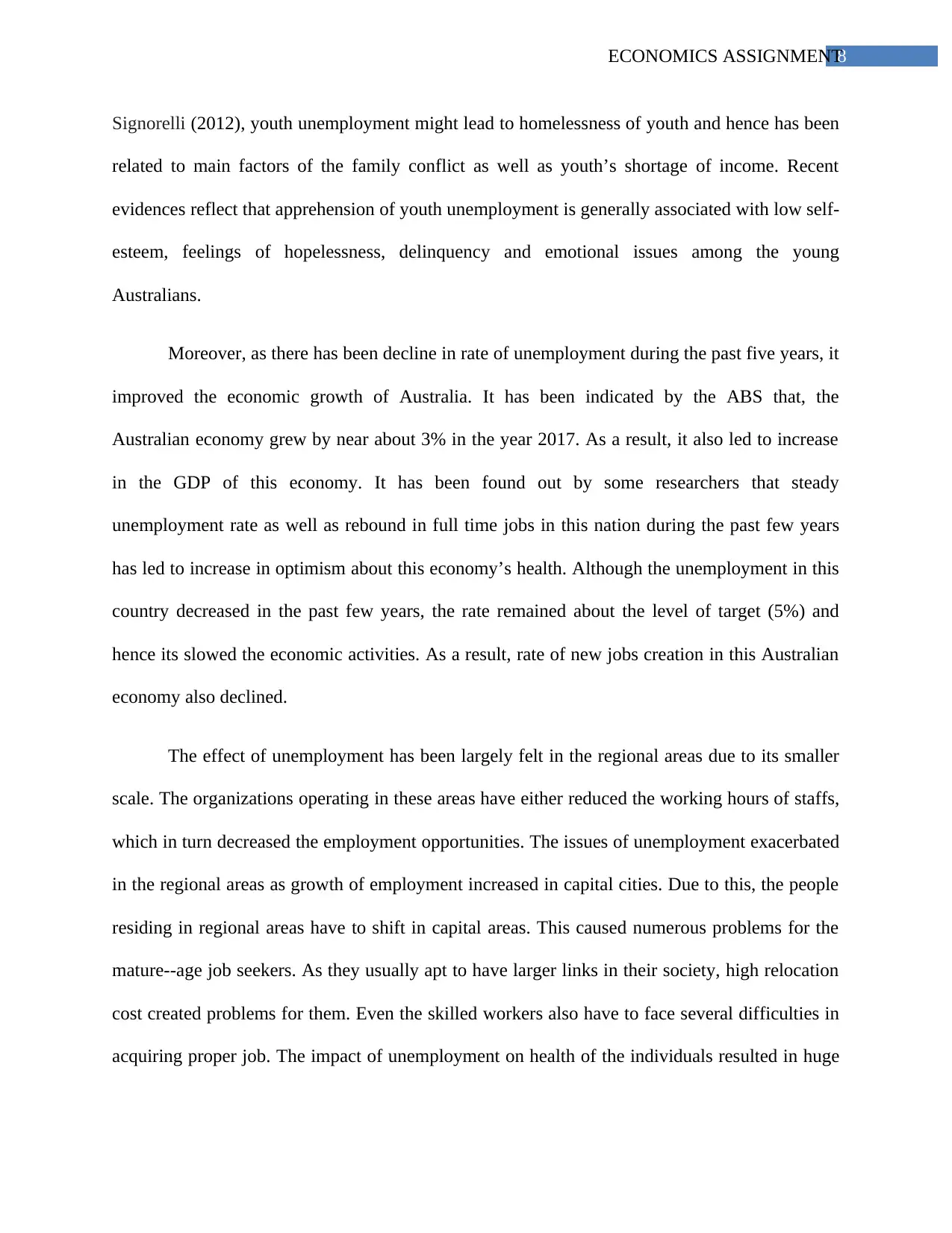
8ECONOMICS ASSIGNMENT
Signorelli (2012), youth unemployment might lead to homelessness of youth and hence has been
related to main factors of the family conflict as well as youth’s shortage of income. Recent
evidences reflect that apprehension of youth unemployment is generally associated with low self-
esteem, feelings of hopelessness, delinquency and emotional issues among the young
Australians.
Moreover, as there has been decline in rate of unemployment during the past five years, it
improved the economic growth of Australia. It has been indicated by the ABS that, the
Australian economy grew by near about 3% in the year 2017. As a result, it also led to increase
in the GDP of this economy. It has been found out by some researchers that steady
unemployment rate as well as rebound in full time jobs in this nation during the past few years
has led to increase in optimism about this economy’s health. Although the unemployment in this
country decreased in the past few years, the rate remained about the level of target (5%) and
hence its slowed the economic activities. As a result, rate of new jobs creation in this Australian
economy also declined.
The effect of unemployment has been largely felt in the regional areas due to its smaller
scale. The organizations operating in these areas have either reduced the working hours of staffs,
which in turn decreased the employment opportunities. The issues of unemployment exacerbated
in the regional areas as growth of employment increased in capital cities. Due to this, the people
residing in regional areas have to shift in capital areas. This caused numerous problems for the
mature--age job seekers. As they usually apt to have larger links in their society, high relocation
cost created problems for them. Even the skilled workers also have to face several difficulties in
acquiring proper job. The impact of unemployment on health of the individuals resulted in huge
Signorelli (2012), youth unemployment might lead to homelessness of youth and hence has been
related to main factors of the family conflict as well as youth’s shortage of income. Recent
evidences reflect that apprehension of youth unemployment is generally associated with low self-
esteem, feelings of hopelessness, delinquency and emotional issues among the young
Australians.
Moreover, as there has been decline in rate of unemployment during the past five years, it
improved the economic growth of Australia. It has been indicated by the ABS that, the
Australian economy grew by near about 3% in the year 2017. As a result, it also led to increase
in the GDP of this economy. It has been found out by some researchers that steady
unemployment rate as well as rebound in full time jobs in this nation during the past few years
has led to increase in optimism about this economy’s health. Although the unemployment in this
country decreased in the past few years, the rate remained about the level of target (5%) and
hence its slowed the economic activities. As a result, rate of new jobs creation in this Australian
economy also declined.
The effect of unemployment has been largely felt in the regional areas due to its smaller
scale. The organizations operating in these areas have either reduced the working hours of staffs,
which in turn decreased the employment opportunities. The issues of unemployment exacerbated
in the regional areas as growth of employment increased in capital cities. Due to this, the people
residing in regional areas have to shift in capital areas. This caused numerous problems for the
mature--age job seekers. As they usually apt to have larger links in their society, high relocation
cost created problems for them. Even the skilled workers also have to face several difficulties in
acquiring proper job. The impact of unemployment on health of the individuals resulted in huge
⊘ This is a preview!⊘
Do you want full access?
Subscribe today to unlock all pages.

Trusted by 1+ million students worldwide
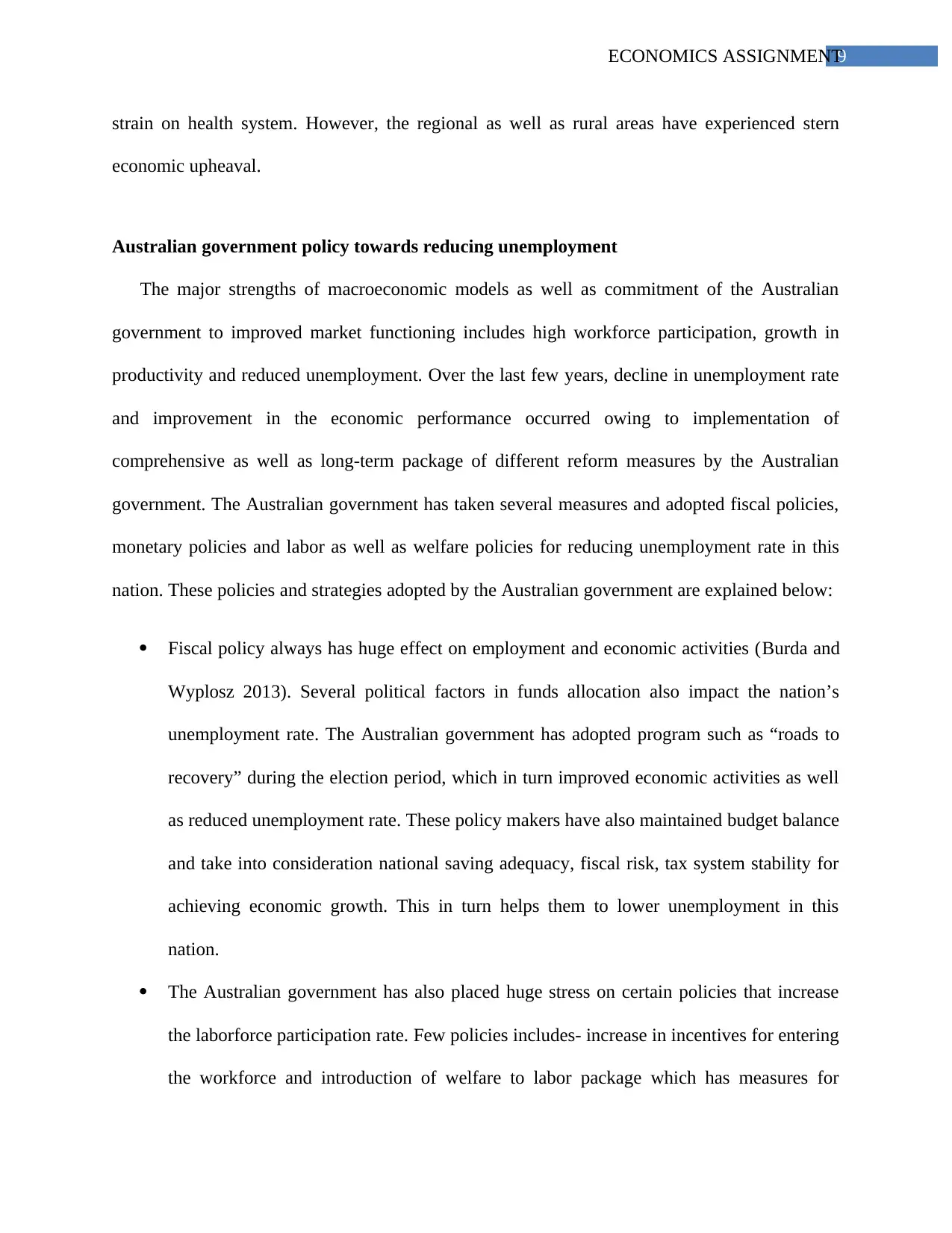
9ECONOMICS ASSIGNMENT
strain on health system. However, the regional as well as rural areas have experienced stern
economic upheaval.
Australian government policy towards reducing unemployment
The major strengths of macroeconomic models as well as commitment of the Australian
government to improved market functioning includes high workforce participation, growth in
productivity and reduced unemployment. Over the last few years, decline in unemployment rate
and improvement in the economic performance occurred owing to implementation of
comprehensive as well as long-term package of different reform measures by the Australian
government. The Australian government has taken several measures and adopted fiscal policies,
monetary policies and labor as well as welfare policies for reducing unemployment rate in this
nation. These policies and strategies adopted by the Australian government are explained below:
Fiscal policy always has huge effect on employment and economic activities (Burda and
Wyplosz 2013). Several political factors in funds allocation also impact the nation’s
unemployment rate. The Australian government has adopted program such as “roads to
recovery” during the election period, which in turn improved economic activities as well
as reduced unemployment rate. These policy makers have also maintained budget balance
and take into consideration national saving adequacy, fiscal risk, tax system stability for
achieving economic growth. This in turn helps them to lower unemployment in this
nation.
The Australian government has also placed huge stress on certain policies that increase
the laborforce participation rate. Few policies includes- increase in incentives for entering
the workforce and introduction of welfare to labor package which has measures for
strain on health system. However, the regional as well as rural areas have experienced stern
economic upheaval.
Australian government policy towards reducing unemployment
The major strengths of macroeconomic models as well as commitment of the Australian
government to improved market functioning includes high workforce participation, growth in
productivity and reduced unemployment. Over the last few years, decline in unemployment rate
and improvement in the economic performance occurred owing to implementation of
comprehensive as well as long-term package of different reform measures by the Australian
government. The Australian government has taken several measures and adopted fiscal policies,
monetary policies and labor as well as welfare policies for reducing unemployment rate in this
nation. These policies and strategies adopted by the Australian government are explained below:
Fiscal policy always has huge effect on employment and economic activities (Burda and
Wyplosz 2013). Several political factors in funds allocation also impact the nation’s
unemployment rate. The Australian government has adopted program such as “roads to
recovery” during the election period, which in turn improved economic activities as well
as reduced unemployment rate. These policy makers have also maintained budget balance
and take into consideration national saving adequacy, fiscal risk, tax system stability for
achieving economic growth. This in turn helps them to lower unemployment in this
nation.
The Australian government has also placed huge stress on certain policies that increase
the laborforce participation rate. Few policies includes- increase in incentives for entering
the workforce and introduction of welfare to labor package which has measures for
Paraphrase This Document
Need a fresh take? Get an instant paraphrase of this document with our AI Paraphraser
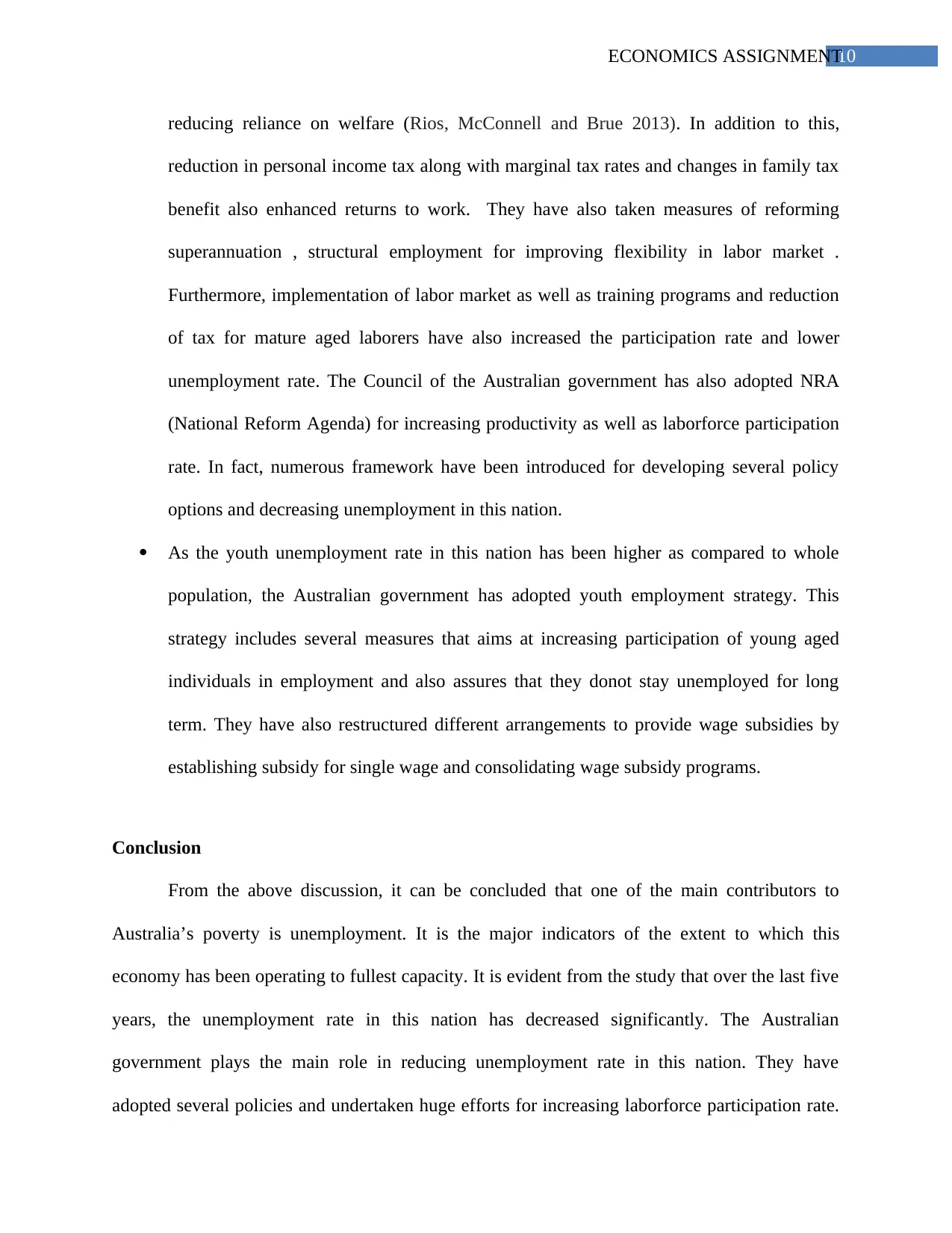
10ECONOMICS ASSIGNMENT
reducing reliance on welfare (Rios, McConnell and Brue 2013). In addition to this,
reduction in personal income tax along with marginal tax rates and changes in family tax
benefit also enhanced returns to work. They have also taken measures of reforming
superannuation , structural employment for improving flexibility in labor market .
Furthermore, implementation of labor market as well as training programs and reduction
of tax for mature aged laborers have also increased the participation rate and lower
unemployment rate. The Council of the Australian government has also adopted NRA
(National Reform Agenda) for increasing productivity as well as laborforce participation
rate. In fact, numerous framework have been introduced for developing several policy
options and decreasing unemployment in this nation.
As the youth unemployment rate in this nation has been higher as compared to whole
population, the Australian government has adopted youth employment strategy. This
strategy includes several measures that aims at increasing participation of young aged
individuals in employment and also assures that they donot stay unemployed for long
term. They have also restructured different arrangements to provide wage subsidies by
establishing subsidy for single wage and consolidating wage subsidy programs.
Conclusion
From the above discussion, it can be concluded that one of the main contributors to
Australia’s poverty is unemployment. It is the major indicators of the extent to which this
economy has been operating to fullest capacity. It is evident from the study that over the last five
years, the unemployment rate in this nation has decreased significantly. The Australian
government plays the main role in reducing unemployment rate in this nation. They have
adopted several policies and undertaken huge efforts for increasing laborforce participation rate.
reducing reliance on welfare (Rios, McConnell and Brue 2013). In addition to this,
reduction in personal income tax along with marginal tax rates and changes in family tax
benefit also enhanced returns to work. They have also taken measures of reforming
superannuation , structural employment for improving flexibility in labor market .
Furthermore, implementation of labor market as well as training programs and reduction
of tax for mature aged laborers have also increased the participation rate and lower
unemployment rate. The Council of the Australian government has also adopted NRA
(National Reform Agenda) for increasing productivity as well as laborforce participation
rate. In fact, numerous framework have been introduced for developing several policy
options and decreasing unemployment in this nation.
As the youth unemployment rate in this nation has been higher as compared to whole
population, the Australian government has adopted youth employment strategy. This
strategy includes several measures that aims at increasing participation of young aged
individuals in employment and also assures that they donot stay unemployed for long
term. They have also restructured different arrangements to provide wage subsidies by
establishing subsidy for single wage and consolidating wage subsidy programs.
Conclusion
From the above discussion, it can be concluded that one of the main contributors to
Australia’s poverty is unemployment. It is the major indicators of the extent to which this
economy has been operating to fullest capacity. It is evident from the study that over the last five
years, the unemployment rate in this nation has decreased significantly. The Australian
government plays the main role in reducing unemployment rate in this nation. They have
adopted several policies and undertaken huge efforts for increasing laborforce participation rate.

11ECONOMICS ASSIGNMENT
Implementation of these policies improved the standard of living and economic growth of this
nation. Even the exacerbating issues regarding inequality among the individuals also resolved
owing to decline in unemployment. Moreover, change in labor policies including the flexible
wage conditions as well as employment arrangements, fiscal and monetary policies also led to
reduction in unemployment. It is therefore suggested by few economist that the Australian
government must keep growth of economy high for maintaining low unemployment rate in the
country.
Implementation of these policies improved the standard of living and economic growth of this
nation. Even the exacerbating issues regarding inequality among the individuals also resolved
owing to decline in unemployment. Moreover, change in labor policies including the flexible
wage conditions as well as employment arrangements, fiscal and monetary policies also led to
reduction in unemployment. It is therefore suggested by few economist that the Australian
government must keep growth of economy high for maintaining low unemployment rate in the
country.
⊘ This is a preview!⊘
Do you want full access?
Subscribe today to unlock all pages.

Trusted by 1+ million students worldwide
1 out of 14
Related Documents
Your All-in-One AI-Powered Toolkit for Academic Success.
+13062052269
info@desklib.com
Available 24*7 on WhatsApp / Email
![[object Object]](/_next/static/media/star-bottom.7253800d.svg)
Unlock your academic potential
Copyright © 2020–2025 A2Z Services. All Rights Reserved. Developed and managed by ZUCOL.





